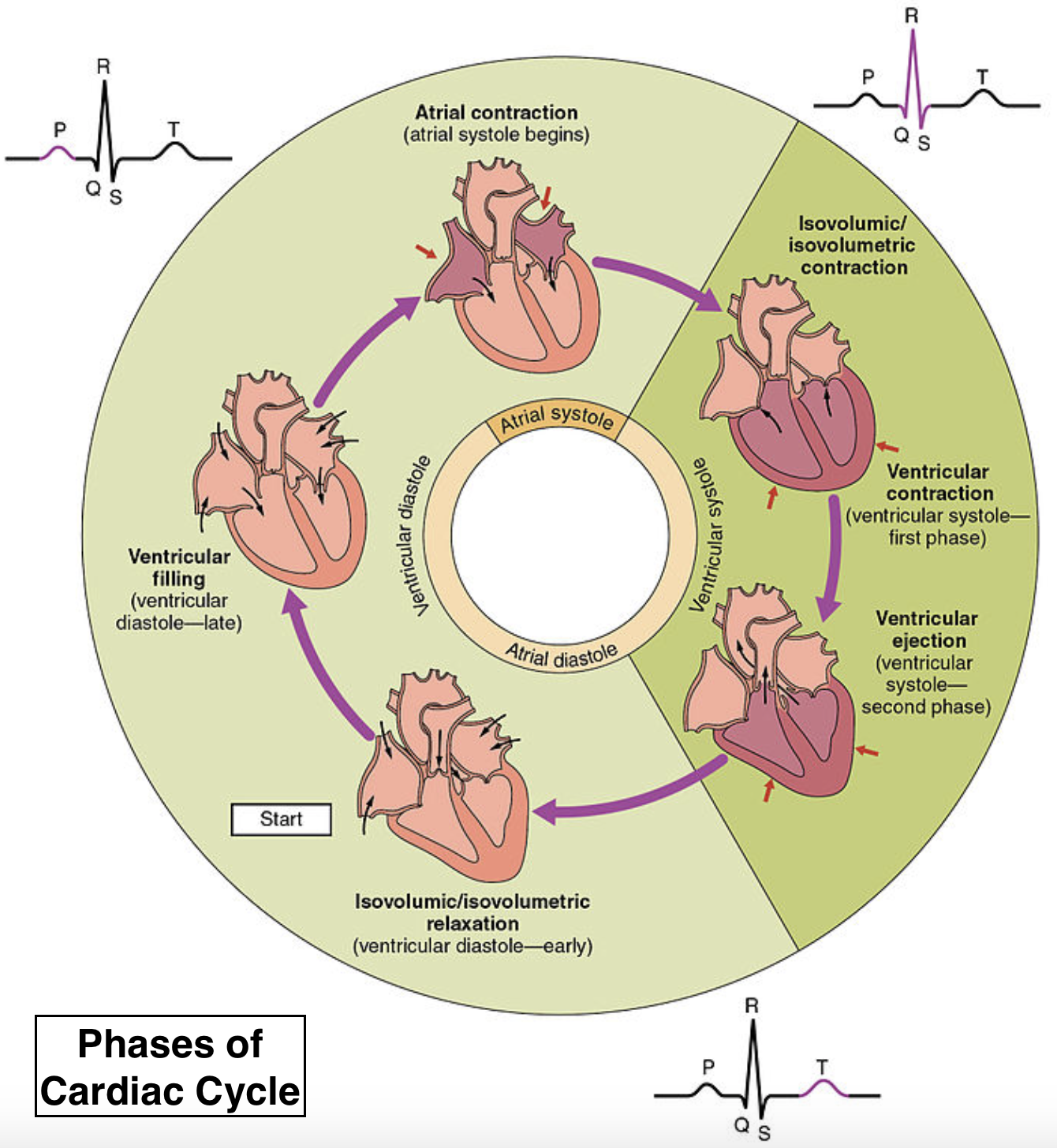
Define the cardiac cycle. Describe various events of the cardiac cycle.
Answer
556.8k+ views
Hint: Cardiac cycle is the rhythmic and cyclic series of electrical and mechanical events, taking place during a heartbeat.
Complete answer:
It consists of two major sets of events, namely auricular events and ventricular events. These are completed in four stages, namely auricular systole, auricular diastole, ventricular systole, and ventricular diastole. The short interval between the end of one cycle and the beginning of the next is called the refractory period. In a healthy individual, the average rate of heartbeat is 72 times per minute. Then, the duration of the cardiac cycle is $60/72= 0.83 s$. The duration of the cardiac cycle is inversely proportional to the rate of heartbeat. The stages of the cardiac cycle can be roughly divided into four stages: The filling phase, Isovolumetric contraction, building up pressure ready to pump blood into the aorta or pulmonary trunk.

During the filling phase, the ventricles are filled with blood in two stages – diastole (heart relaxation) and atrial systole. The stage of Isovolumetric contraction lasts for approximately 50ms while the pressure builds. During the outflow phase the pressure in the ventricles exceeds the pressure in the aorta or pulmonary trunk, the outflow valves open. Blood is pumped from the heart into the great arteries. At the end of the outflow phase, both sets of valves are closed once again. The ventricles begin to relax, reducing the pressure in the ventricles so that the atrioventricular valves open. The ventricles then begin to fill with blood and the cycle begins once again
Additional Information:
- In diastole, both the atria and the ventricles are relaxed. Blood flows from the vena cava and pulmonary veins into the right and left atria respectively, before flowing directly into the ventricles.
- As contraction begins both sets of valves are closed, meaning that no blood can escape from the ventricles. The start of systole therefore massively increases the pressure within the ventricles, ready to eject blood into the aorta and pulmonary trunk.
Note:
- Human heart is a central muscular pressure pump, concerned with the collection, storage, and pumping of blood.
- It’s rhythmic beating keeps the blood in constant circulation. The human heart is a tetralocular or four-chambered organ, with two upper and two lower chambers.
- It’s upper chambers are called auricles of the atria, and the lower ones are called ventricles.
Complete answer:
It consists of two major sets of events, namely auricular events and ventricular events. These are completed in four stages, namely auricular systole, auricular diastole, ventricular systole, and ventricular diastole. The short interval between the end of one cycle and the beginning of the next is called the refractory period. In a healthy individual, the average rate of heartbeat is 72 times per minute. Then, the duration of the cardiac cycle is $60/72= 0.83 s$. The duration of the cardiac cycle is inversely proportional to the rate of heartbeat. The stages of the cardiac cycle can be roughly divided into four stages: The filling phase, Isovolumetric contraction, building up pressure ready to pump blood into the aorta or pulmonary trunk.

During the filling phase, the ventricles are filled with blood in two stages – diastole (heart relaxation) and atrial systole. The stage of Isovolumetric contraction lasts for approximately 50ms while the pressure builds. During the outflow phase the pressure in the ventricles exceeds the pressure in the aorta or pulmonary trunk, the outflow valves open. Blood is pumped from the heart into the great arteries. At the end of the outflow phase, both sets of valves are closed once again. The ventricles begin to relax, reducing the pressure in the ventricles so that the atrioventricular valves open. The ventricles then begin to fill with blood and the cycle begins once again
Additional Information:
- In diastole, both the atria and the ventricles are relaxed. Blood flows from the vena cava and pulmonary veins into the right and left atria respectively, before flowing directly into the ventricles.
- As contraction begins both sets of valves are closed, meaning that no blood can escape from the ventricles. The start of systole therefore massively increases the pressure within the ventricles, ready to eject blood into the aorta and pulmonary trunk.
Note:
- Human heart is a central muscular pressure pump, concerned with the collection, storage, and pumping of blood.
- It’s rhythmic beating keeps the blood in constant circulation. The human heart is a tetralocular or four-chambered organ, with two upper and two lower chambers.
- It’s upper chambers are called auricles of the atria, and the lower ones are called ventricles.
Recently Updated Pages
Master Class 12 Business Studies: Engaging Questions & Answers for Success

Master Class 12 Economics: Engaging Questions & Answers for Success

Master Class 12 English: Engaging Questions & Answers for Success

Master Class 12 Maths: Engaging Questions & Answers for Success

Master Class 12 Social Science: Engaging Questions & Answers for Success

Master Class 12 Chemistry: Engaging Questions & Answers for Success

Trending doubts
What is meant by exothermic and endothermic reactions class 11 chemistry CBSE

Which animal has three hearts class 11 biology CBSE

10 examples of friction in our daily life

One Metric ton is equal to kg A 10000 B 1000 C 100 class 11 physics CBSE

1 Quintal is equal to a 110 kg b 10 kg c 100kg d 1000 class 11 physics CBSE

Difference Between Prokaryotic Cells and Eukaryotic Cells




